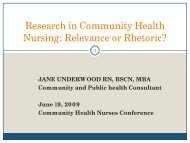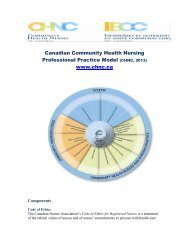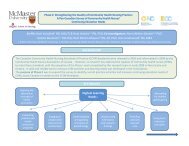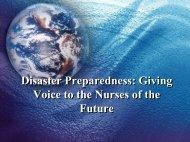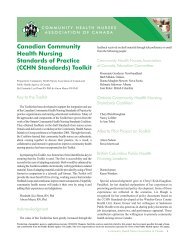Introducing Competency-Based Employee Performance ...
Introducing Competency-Based Employee Performance ...
Introducing Competency-Based Employee Performance ...
You also want an ePaper? Increase the reach of your titles
YUMPU automatically turns print PDFs into web optimized ePapers that Google loves.
<strong>Introducing</strong> <strong>Competency</strong>-<strong>Based</strong><br />
<strong>Employee</strong> <strong>Performance</strong><br />
Management for Public Health<br />
Nurses: A Toolkit and Piloting<br />
Strategy<br />
CHNC Pre-Conference Workshop, May 16, 2011<br />
Caroline Ball BEd, MHK City of Hamilton, Public Health Services<br />
Maureen Cava RN, BScN, MN, FCCHSE Toronto Public Health<br />
Heather Lokko BScN, RN, MPH Middlesex-London Health Unit
PRE-CONFERENCE WORKSHOP<br />
<strong>Introducing</strong> <strong>Competency</strong>-<strong>Based</strong> <strong>Employee</strong> <strong>Performance</strong> Management for Public Health Nurses:<br />
A Toolkit and Piloting Strategy<br />
Monday, May 16 th , 2011 (1:00-5:00 p.m.), Community Health Nurses Conference, Halifax, Nova Scotia<br />
TOPIC FACILITATOR TIME<br />
Introduction Maureen Cava 1:00-1:10 p.m.<br />
Background and History Maureen Cava 1:10-1:25<br />
Overview of Toolkit Maureen Cava 1:25-1:40<br />
Middlesex-London Health Adaption Heather Lokko 1:40-1:55<br />
Hamilton Public Health Adaption Caroline Ball via video 1:55-2:10<br />
Video Maureen Cava 2:10-2:25<br />
Demonstration of Toolkit in Practice Phase A<br />
<strong>Performance</strong> Objectives<br />
BREAK (2:50-3:10)<br />
Heather Lokko 2:25-2:50<br />
Demonstration of Toolkit in Practice Continuation of Phase A<br />
Learning Objectives<br />
Heather Lokko 3:10-3:30<br />
Phase B<br />
process)<br />
(mid cycle of<br />
Heather Lokko 3:30-3:40<br />
Phase C<br />
(end of process)<br />
Heather Lokko 3:40-4:05<br />
Strategies for <strong>Introducing</strong> the Toolkit into Practice<br />
Lessons Learned<br />
Heather Lokko<br />
Maureen Cava<br />
4:05-4:40<br />
Conclusion, Wrap-up and Evaluation Maureen Cava 4:40-5:00
Background<br />
• September 2007 – Core Competencies for<br />
Public Health in Canada Release 1.0 launched<br />
• October 2008 HealthForceOntario funds OPHA<br />
partnership to develop a framework and tools,<br />
bringing together CC’s and performance<br />
management<br />
• Partners include: OPHA, City of Hamilton,<br />
Toronto Public Health, Haliburton Kawartha<br />
Pine Ridge District Health Unit, Thunder Bay<br />
District Health Unit
Project Purpose<br />
“ To develop a competency-based<br />
performance management (human<br />
resources) framework and tools that<br />
will support public health units<br />
across Ontario”.
What is <strong>Competency</strong>-<strong>Based</strong><br />
<strong>Performance</strong> Management?<br />
• HR strategy intended to support work<br />
performance, learning & development activities<br />
of employees<br />
• <strong>Based</strong> on 12-month cycle of planning,<br />
monitoring and evaluating employee<br />
performance and competency development<br />
• A competency-based approach focuses on<br />
competencies (knowledge, skills & abilities)<br />
described in behavioural terms required for<br />
successful job performance
CBPM and Organizational <strong>Performance</strong><br />
Improves organizational performance by:<br />
• Linking job requirements to organizational goals<br />
• Providing a consistent process to assess<br />
performance of all PH employees in organization<br />
• Empowering employees to build their<br />
competencies<br />
• Supporting HR management practices to recruit<br />
the right people and identify learning gaps in the<br />
organization<br />
Can be used with discipline-specific, organizational<br />
or program standards.
• Step 1: Become knowledgeable about competencybased<br />
performance management.<br />
• Step 2: Review the competencies and translate into<br />
a performance management context and language.<br />
◦ 8 Ontario Public Health <strong>Performance</strong> Management<br />
Competencies<br />
• Discussion of leadership domain, which included ‘ethics and<br />
professionalism’. Determined that this should stand alone as an 8 th<br />
competency area related to performance management.<br />
• Step 3: <strong>Competency</strong> profiling<br />
◦ Describe each competency using behavioural statements<br />
and based on one of 4 cumulative proficiency levels.<br />
◦ For each competency area, determine which proficiency<br />
levels would best describe what is required of a frontline,<br />
consultant/specialist, manager/supervisor.
Key Project Activities<br />
• Environmental scan of Ontario PHU’s<br />
• Develop a <strong>Competency</strong>-<strong>Based</strong> <strong>Performance</strong><br />
Management Framework<br />
• Seek consensus from cross-section of PH<br />
professional groups and organizations<br />
• Develop tools that incorporate the new<br />
framework<br />
• Pre-test the tools, get feedback and refine<br />
• Evaluate the project<br />
• Identify opportunities to leverage and advance<br />
the use of the tools
Competencies<br />
• Professional and technical knowledge<br />
• Assessment and analysis<br />
• Policy and program planning, implementation<br />
and evaluation<br />
• Partnerships, collaboration and advocacy<br />
• Diversity and inclusiveness<br />
• Communication<br />
• Leadership<br />
• Ethics and professionalism
Project Design<br />
Phase<br />
(May-June 2010)<br />
PHS <strong>Employee</strong><br />
<strong>Performance</strong><br />
Management Pilot<br />
Plan:<br />
Project Phases<br />
&Timelines<br />
Participant Evaluation Phase Wrap-up (Oct)<br />
PM Tools<br />
Preparation<br />
(July-Aug 2010)<br />
Pre-Pilot<br />
Participant<br />
Training<br />
(Sep-Oct 2010)<br />
Stage 1: Planning for<br />
<strong>Performance</strong> (Nov-Jan 2011)<br />
- <strong>Competency</strong> profile review<br />
- Set performance objectives<br />
- Create learning objectives/<br />
learning plan<br />
Participant Check-In @ 4 months (Feb 2011)<br />
Stage 3: Evaluating<br />
<strong>Performance</strong> (Sep-Oct 2011)<br />
- Self assessment<br />
-Outcomes and results<br />
<strong>Performance</strong> rating<br />
Stage 2: Implementation/<br />
Monitoring (Feb-Aug 2011)<br />
- Ongoing review<br />
- Coaching and feedback<br />
Participant Check-In @ 8 months (June 2011)<br />
Close Project<br />
(Dec 2011)
Toolkit Overview<br />
Section 1 – Leader’s Guide to Implementation<br />
Section 2 – Guidebook for Managers & <strong>Employee</strong>s<br />
Section 3 – <strong>Competency</strong> <strong>Based</strong> <strong>Performance</strong><br />
Management Tools & Resources
<strong>Performance</strong> Management Cycle<br />
Evaluation<br />
Survey<br />
Dec<br />
Final Survey<br />
January 2012<br />
1. <strong>Performance</strong> Planning<br />
What must be achieved?<br />
To what standard?<br />
What competencies are needed?<br />
What development is needed<br />
and how?<br />
Training: Jan 10 or 17<br />
Timing: Jan 10-Feb 15<br />
Evaluation<br />
Evaluation<br />
Survey<br />
Survey<br />
Feb15-28<br />
Feb15-28<br />
3. <strong>Performance</strong> Evaluation<br />
How did I do?<br />
How can I do better?<br />
What have I learned?<br />
Where do I need to further<br />
develop?<br />
Timing: Sept 1 – Dec 15<br />
2. Ongoing Review & Feedback<br />
How am I doing?<br />
Can I do better?<br />
Has anything changed?<br />
Timing: formal review at mid-cycle;<br />
ongoing feedback throughout the<br />
cycle<br />
Timing: May 1- Aug 31<br />
Support Meeting<br />
With Managers<br />
Evaluation<br />
Survey<br />
Aug 15-31<br />
Support Meeting<br />
With Managers
<strong>Performance</strong> Management E Learning Website<br />
www.corecompetencies.ca/performance_elearning
Middlesex-London Health Unit<br />
Integrating the Public Health<br />
Nursing Discipline Specific<br />
Competencies and the OPHA<br />
<strong>Competency</strong> <strong>Based</strong><br />
<strong>Performance</strong> Management<br />
Toolkit for Public Health<br />
Heather Lokko, RN, BScN, CCHN(C), MPH<br />
Program Manager, Child Health Team
Background<br />
• Previous work at MLHU – tool based on<br />
CCHN Standards of Practice developed<br />
and piloted<br />
• MPH practicum placement “to complete<br />
revisions based on recommendations<br />
from pilot & from Directors, and<br />
implement new tool”<br />
• Funding from MLHU and the Public<br />
Health Agency of Canada
Supporting Documents<br />
• <strong>Competency</strong> <strong>Based</strong> <strong>Performance</strong><br />
Management Toolkit for Public Health<br />
(OPHA, 2009)<br />
• Public Health Nursing Discipline Specific<br />
Competencies (CHNC, 2009)<br />
• Adapting the performance appraisal<br />
system for public health nurses to reflect<br />
expertise in applying the Canadian<br />
Community Health Nursing Standards<br />
and the Public Health Core<br />
Competencies (Sealy et al, 2009)
Consultation with Stakeholders<br />
• Internal<br />
◦ Program Managers & Directors<br />
◦ Human Resources Manager<br />
◦ <strong>Performance</strong> Evaluation Staff Advisory Group<br />
(PHN representation across health unit)<br />
◦ Community Health Nursing Specialist<br />
◦ Nursing Practice Council<br />
• External<br />
◦ Caroline Ball (Hamilton Public Health<br />
Services)<br />
◦ Two provincial nursing leaders/consultants
Tool Development<br />
• <strong>Performance</strong> Management tool<br />
◦ Adapted from the Toolkit<br />
◦ Revised to reflect Public Health Nursing<br />
Discipline-Specific Competencies<br />
◦ Incorporated input & recommendations from<br />
pilot project and stakeholders<br />
• Public Health Nurse job description
Competencies<br />
• Public health nursing competencies are<br />
the observable and integrated knowledge,<br />
skills, judgment and attributes required of<br />
a public health nurse to practice safely,<br />
ethically, and effectively with minimal<br />
supervision. Attributes include, but are<br />
not limited to, attitudes, values, and<br />
beliefs.<br />
(Adapted from the definitions available in the Public Health Nursing Discipline Specific Competencies<br />
(http://www.chnc.ca/nursing-publications.cfm), College of Nurses of Ontario<br />
(http://www.cno.org/docs/qa/44028_CRT.pdf) , and MLHU <strong>Performance</strong> Appraisal Pilot Project<br />
recommendations)
Self-Assessment Rating Scale<br />
• Rarely<br />
• Sometimes<br />
• Often<br />
• Always<br />
• Challenging Situations; Mentoring &/or<br />
Consultation<br />
• Limited or No Opportunity to Practice<br />
Overall Rating Scale
Face Validity<br />
• Extent to which an instrument looks as if<br />
it measures what it is intended to<br />
measure (Patton, 2008)<br />
• Generally judged by clinical/practitioner &<br />
theoretical experts (Green & Lewis, 1986)<br />
• Increases user‟s understanding of &<br />
confidence in the data (Patton, 2008)<br />
• Weaker than criterion or construct<br />
validity<br />
• Qualitative feedback is most helpful
Face Validation Results<br />
• Move indicators into more appropriate<br />
levels<br />
• Change wording slightly to make concepts<br />
clearer<br />
• Adapt indicators slightly so they more<br />
adequately reflect PHN practice<br />
• Modify wording somewhat to increase<br />
measurability<br />
• Add indicators to address gaps
Other recommendations<br />
• Examples:<br />
◦ Glossary of terms<br />
◦ Comprehensive orientation & ongoing<br />
support<br />
◦ Clarify use with novice practitioners<br />
◦ Optional review of additional levels<br />
◦ Provide practice examples
Implementation<br />
• Approval from Directors<br />
• Process chart to guide use<br />
• Orientation for each team (done<br />
individually to better meet needs of each<br />
program area)<br />
• Ongoing support to managers & staff, as<br />
requested<br />
• Will be holding discussion session for<br />
managers
<strong>Competency</strong> Categories & Indicators<br />
• Explore concepts in the indicators &<br />
identify practice examples<br />
◦ Public Health & Nursing Sciences<br />
◦ Assessment & Analysis<br />
◦ Program & Policy Planning, Implementation &<br />
Evaluation<br />
◦ Partnerships, Collaboration & Advocacy<br />
◦ Communication<br />
◦ Leadership<br />
◦ Ethics, Professional Responsibility &<br />
Accountability
City of Hamilton,<br />
Public Health Services<br />
Adapting the OPHA &<br />
Partners <strong>Employee</strong><br />
<strong>Performance</strong> Management for<br />
Public Health Toolkit for Use<br />
by Public Health Nurses: The<br />
Hamilton (V 2.0) Experience<br />
Caroline Ball B.Ed, MHK<br />
Project Manager, Core Competencies
„Next Generation‟ Nursing PM Toolkit<br />
Adaptation: City of Hamilton Public<br />
Health Services<br />
Objectives:<br />
◦ Build on the London Tool (V 1.0)<br />
◦ Further adapt tools for use in<br />
Hamilton (V 2.0)<br />
◦ Engage nurses in review of V 2.0<br />
◦ Revise tools for „real time‟ piloting<br />
◦ Plan and implement piloting in 2011
Toolkit Components for Review<br />
and Adaptation<br />
• Guide to CBPM for Public Health<br />
• Self Assessment Tool<br />
• MLHU (V 1.0) Public Health<br />
Nursing Discipline Specific<br />
Competencies<br />
• MLHU (V 1.0) Public Health<br />
Nursing Discipline Specific<br />
<strong>Competency</strong> Profiles<br />
• Planning and Evaluation Tool
V 2.0 Toolkit Adaptation Process Activities<br />
✔Adapted V 1.0 Toolkit<br />
Review (May „10)<br />
• Review London V 1.0 behavioural<br />
statements and forms for fit<br />
• Feedback via „expert panel‟ questionnaire<br />
✔Adapted V 2.0 Toolkit<br />
Review (July „10)<br />
✔Pre-Test and further<br />
revise V 2.0 (Sept „10)<br />
• 2 cross-department nurse consultation<br />
sessions (45 participants)<br />
• Additional stakeholder feedback<br />
• Expert panel review of revised tools<br />
✔Design 2011 Pilot Plan<br />
(Nov „10)<br />
• Develop basic pilot design elements<br />
Confirm Management<br />
Endorsement (pending)<br />
• Approval for 2011 “Real Time” Pilot Plan<br />
(WE ARE HERE)
Hamilton PHS<br />
Nursing<br />
Competencies<br />
Adapted <strong>Performance</strong><br />
Management Toolkit<br />
(V 2.0)<br />
PM Tools<br />
Preparation<br />
(2 months)<br />
Pre-Pilot<br />
Participant<br />
Training<br />
(1 month)<br />
Stage 1: Planning for<br />
<strong>Performance</strong> (2 months)<br />
- <strong>Competency</strong> profile review<br />
- Set performance objectives<br />
- Create learning objectives/<br />
learning plan<br />
2011/2012<br />
Pilot Plan:<br />
Participant Evaluation Phase<br />
Wrap-up @ 12 months<br />
Participant Check-In @ 3 months<br />
Proposed<br />
Project Activities<br />
&Timelines<br />
Stage 3: Evaluating<br />
<strong>Performance</strong> (2 months)<br />
- Self assessment<br />
-Outcomes and results<br />
<strong>Performance</strong> rating<br />
Participant Check-In @ 8 months (June 2011)<br />
Stage 2: Implementation/<br />
Monitoring (7 months)<br />
- Ongoing review<br />
- Coaching and feedback<br />
Close Project<br />
(1 month)
Step 1: Tools Preparation<br />
Technical review of<br />
Nursing-specific adapted<br />
PM toolkit<br />
PM Tools<br />
Preparation<br />
(2 months)<br />
Pre-Pilot<br />
Participant<br />
Training<br />
(1 month)<br />
Stage 1: Planning for<br />
<strong>Performance</strong> (2 months)<br />
- <strong>Competency</strong> profile review<br />
- Set performance objectives<br />
- Create learning objectives/<br />
learning plan<br />
Revise to align with<br />
corporate requirements<br />
Endorsement and support<br />
from corporate leadership<br />
team<br />
Participant Evaluation Phase<br />
Wrap-up @ 12 months<br />
Stage 3: Evaluating<br />
<strong>Performance</strong> (2 months)<br />
- Self assessment<br />
-Outcomes and results<br />
<strong>Performance</strong> rating<br />
Participant Check-In @ 8 months (June 2011)<br />
Close Project<br />
(1 month)<br />
Participant Check-In @ 3 months<br />
Stage 2: Implementation/<br />
Monitoring (7 months)<br />
- Ongoing review<br />
- Coaching and feedback
Step 2: Pre-Pilot Participant<br />
Training<br />
Recruit supervisor/staff<br />
dyads<br />
Complete initial<br />
introductory e-learning<br />
module (self-guided)<br />
Complete half-day training<br />
sessions<br />
Participant Evaluation Phase<br />
Wrap-up @ 12 months<br />
Stage 3: Evaluating<br />
<strong>Performance</strong> (2 months)<br />
- Self assessment<br />
-Outcomes and results<br />
<strong>Performance</strong> rating<br />
PM Tools<br />
Preparation<br />
(2 months)<br />
Pre-Pilot<br />
Participant<br />
Training<br />
(1 month)<br />
Stage 1: Planning for<br />
<strong>Performance</strong> (2 months)<br />
- <strong>Competency</strong> profile review<br />
- Set performance objectives<br />
- Create learning objectives/<br />
learning plan<br />
Participant Check-In @ 3 months<br />
Stage 2: Implementation/<br />
Monitoring (7 months)<br />
- Ongoing review<br />
- Coaching and feedback<br />
Individualized consultation<br />
as required<br />
Participant Check-In @ 8 months (June 2011)<br />
Close Project<br />
(1 month)
Pilot Implementation<br />
Process<br />
Stage 1:<br />
Planning for <strong>Performance</strong><br />
<strong>Competency</strong> profile review<br />
PM Tools<br />
Preparation<br />
(2 months)<br />
Pre-Pilot<br />
Participant<br />
Training<br />
(2 months)<br />
Setting performance<br />
objectives<br />
Participant Evaluation Phase<br />
Wrap-up @ 12 months<br />
Stage 1: Planning for<br />
<strong>Performance</strong> (2 months)<br />
- <strong>Competency</strong> profile review<br />
- Set performance objectives<br />
- Create learning objectives/<br />
learning plan<br />
Participant Check-In @ 3 months<br />
Creating learning objectives<br />
and learning plan<br />
---------------------------------<br />
Participant process<br />
check-in survey @ 3<br />
months<br />
Stage 3: Evaluating<br />
<strong>Performance</strong> (2 months)<br />
- Self assessment<br />
-Outcomes and results<br />
<strong>Performance</strong> rating<br />
Participant Check-In @ 8 months (June 2011)<br />
Close Project<br />
(1 month)<br />
Stage 2: Implementation/<br />
Monitoring (7 months)<br />
- Ongoing review<br />
- Coaching and feedback
Pilot Implementation<br />
Process<br />
Stage 2:<br />
Implementation and<br />
Monitoring<br />
Ongoing review<br />
Participant Evaluation Phase<br />
Wrap-up @ 12 months<br />
PM Tools<br />
Preparation<br />
(2 months)<br />
Pre-Pilot<br />
Participant<br />
Training<br />
(2 months)<br />
Stage 1: Planning for<br />
<strong>Performance</strong> (2 months)<br />
- <strong>Competency</strong> profile review<br />
- Set performance objectives<br />
- Create learning objectives/<br />
learning plan<br />
Participant Check-In @ 3 months<br />
Coaching and feedback<br />
-----------------------------------<br />
Participant process check-in<br />
survey @ 6 months<br />
Stage 3: Evaluating<br />
<strong>Performance</strong> (2 months)<br />
- Self assessment<br />
-Outcomes and results<br />
<strong>Performance</strong> rating<br />
Participant Check-In @ 8 months<br />
Stage 2: Implementation/<br />
Monitoring (7 months)<br />
- Ongoing review<br />
- Coaching and feedback<br />
Close Project<br />
(1 month)
Pilot Implementation<br />
Process<br />
Stage 3:<br />
Evaluating <strong>Performance</strong><br />
Self Assessment<br />
Outcomes and results<br />
Participant Evaluation Phase<br />
Wrap-up @ 12 months<br />
PM Tools<br />
Preparation<br />
(2 months)<br />
Pre-Pilot<br />
Participant<br />
Training<br />
(2 months)<br />
Stage 1: Planning for<br />
<strong>Performance</strong> (2 months)<br />
- <strong>Competency</strong> profile review<br />
- Set performance objectives<br />
- Create learning objectives/<br />
learning plan<br />
Participant Check-In @ 3 months<br />
<strong>Performance</strong> rating<br />
-----------------------------------<br />
---<br />
Final participant process<br />
evaluation survey<br />
@ 12 months<br />
Stage 3: Evaluating<br />
<strong>Performance</strong> (2 months)<br />
- Self assessment<br />
-Outcomes and results<br />
<strong>Performance</strong> rating<br />
Participant Check-In @ 8 months<br />
Close Project<br />
(1 month)<br />
Stage 2: Implementation/<br />
Monitoring (7 months)<br />
- Ongoing review<br />
- Coaching and feedback
Pilot Implementation<br />
Process<br />
Final Phase:<br />
Close Project<br />
Participant process<br />
evaluation review<br />
Participant Evaluation Phase<br />
Wrap-up @ 12 months<br />
PM Tools<br />
Preparation<br />
(2 months)<br />
Pre-Pilot<br />
Participant<br />
Training<br />
(1 month)<br />
Stage 1: Planning for<br />
<strong>Performance</strong> (2 months)<br />
- <strong>Competency</strong> profile review<br />
- Set performance objectives<br />
- Create learning objectives/<br />
learning plan<br />
Participant Check-In @ 3 months<br />
Final Report<br />
& Recommendations<br />
Stage 3: Evaluating<br />
<strong>Performance</strong> (2 months)<br />
- Self assessment<br />
-Outcomes and results<br />
<strong>Performance</strong> rating<br />
Stage 2: Implementation/<br />
Monitoring (7 months)<br />
- Ongoing review<br />
- Coaching and feedback<br />
Document<br />
“lessons learned”<br />
Participant Check-In @ 8 months (June 2011)<br />
Close Project<br />
(1 month)
Proposed Participant Strategy<br />
• 24 total pilot participants from all divisions<br />
• (9) manager/employee dyads; (3) Sr.<br />
manager/manager dyads<br />
• Managers in dyad should be experienced<br />
in performance management process<br />
• Voluntary participation, with commitment<br />
to completing full 12-month process<br />
-------------------------------------------------------------<br />
• Project Advisory Committee<br />
◦ Chief Nursing Officer<br />
◦ Nursing Practice Development Committee
Pilot „Next Steps‟<br />
• Secure pilot endorsement from<br />
management<br />
• Confirm participant strategy<br />
• Confirm project advisory structure<br />
• Implement 3-stage pilot in „real time‟<br />
(12 mos.)<br />
• Evaluate tools and process throughout<br />
the CBPM cycle (“Participant Checkin”)<br />
• Recommendations<br />
• Close project – lessons learned
Strategies to Move Forward &<br />
Lessons Learned<br />
• Have a „lead‟ within the agency<br />
• Build on existing capacity<br />
• Identify & collaborate with internal &<br />
external „partners‟<br />
• Engage leadership, ensure their support &<br />
keep them in the loop<br />
◦ Director‟s meetings, one-on-one meetings,<br />
email updates, opportunities for input
Strategies to Move Forward &<br />
Lessons Learned<br />
• Engage nurses at every level, from a range<br />
of nursing practice areas<br />
• Build understanding of competency-based<br />
performance management & available<br />
tools<br />
• Adapt tools as necessary to suit your<br />
organization
Strategies to Move Forward &<br />
Lessons Learned<br />
• Provide comprehensive orientation &<br />
ongoing support<br />
• Be patient – invest the time that is<br />
needed<br />
◦ To go through the process<br />
◦ To get buy-in and support<br />
◦ To become familiar with the concepts and<br />
explore how they apply to practice<br />
◦ To complete the tool
Thank You!<br />
Caroline Ball – City of Hamilton, Public Health Services<br />
Maureen Cava – Toronto Public Health<br />
Heather Lokko - Middlesex-London Health Unit









